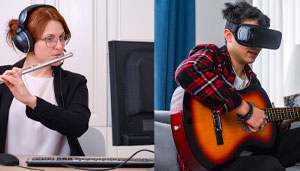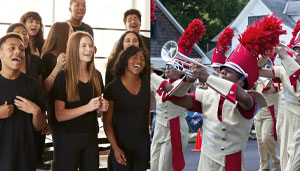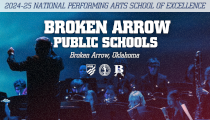Conductor Expressivity Affects Evaluation of Rehearsal Instruction
By Mark Montemayor and Brian A. Silvey on September 08, 2023 advocacy PrintA recent study shows that expressive conducting is integral to the students’ rehearsal and performance experience as well as overall learning.
In school music programs, ensemble conductors serve an iconic role as instructional leaders. Teachers in no other subject matter would seem to be so explicitly reliant on nonverbal communication as a primary means of conveying academic expectations for students during both in-class instruction (i.e., rehearsals) and public demonstrations of summative achievement (performance).
The importance of conducting as a discrete program of study is reflected in its long-standing and seemingly universal inclusion as a requirement for degree programs in music education. In fact, some researchers consider conducting to be the most important pedagogical competency for music education majors to learn. Other research findings indicate that instruction in gesture often takes precedence over rehearsal skills within undergraduate conducting courses.
Expert teachers employ a more varied repertoire of nonverbal instructional skills, including expressive gesture, and they have a more fluent command of conducting behaviors toward specific ends in music teaching compared with less experienced teachers. Expression itself appears to be both a means and an end in effective music teaching, and the deliberate use of gesture seems crucial in this regard. Some researchers have explored the direct influence of gesture — that is, young musicians’ own use of gesture or their own experience with conducting — on their subsequent performance success, with positive effects found among young singers, beginning band students, and high school string orchestra members.
Nonverbal components of high-magnitude music teaching include sustained eye contact, varied and animated facial expressions and gestures, movement on the podium, and a brisk rehearsal pace. Such elements have been associated with effective teaching in the general education research literature, including conducting-related behaviors such as:
Gestures — uses arms and hands to aid in musical phrasing; great variety of movement; varies size of conducting patterns to indicate phrases, dynamics, and the like vs. strict conducting pattern, never varying.
Facial expressions —
face reflects sharp contrasts between approval/disapproval as opposed to neutral mask, no frowns, no smiles.
Further investigations have revealed a more nuanced and complicated set of relationships among expressive gesture, expressive performance, and the perception of visual and aural information among observers. Physical movement itself appears to convey a sense of musical expression to undergraduate musician observers. In a study of music majors’ evaluations of a pianist’s simulated performance, ratings of dynamics, phrasing, and overall musical effect were highest in full-body movement conditions compared to head-and-facial movement and no-movement conditions.
Exploring aspects of expressive conducting from a rehearsal perspective (rather than only by virtue of the performance of the ensemble) would add a meaningful and contextual foundation from which to gather additional information about expressivity for researchers, conducting pedagogues, and practitioners. Thus, we wanted to test whether conductor expressivity would influence musicians’ evaluations of teaching effectiveness in a rehearsal setting while attempting to focus observers’ attention specifically on verbal (i.e., nongestural) aspects of the teacher’s behavior in rehearsal.
The purpose of this study was to examine the effect of conductor expressivity on the evaluation of rehearsal instruction. Would college musicians rate the teaching effectiveness of a conductor differently based on how expressively they conducted?
Method
We video recorded excerpts of two conductors in rehearsal with a university band. Two female graduate students (ages 42 and 31) were chosen to serve as rehearsal conductors. One conductor was assigned to rehearse “Jubilee Overture” by Philip Sparke, with the other given “Valley Montage and Celebration” by Richard Saucedo. These selections were chosen because they would not be played flawlessly during brief ensemble rehearsals, allowing each conductor to respond to musical issues that typically arise in ensemble rehearsals (e.g., rhythmic precision, balance, blend, intonation, phrasing).
For the second conductor, we re-recorded the same rehearsal excerpt with the conductor using unexpressive gestures. In postproduction, we created two versions of this conductor’s rehearsal (one unaltered and expressive, the other altered and unexpressive). We presented the video recordings of both conductors to collegiate musicians (with half viewing the unaltered version and the other half viewing the altered version of the second conductor) via an online survey platform and asked them to evaluate verbal (i.e., nongestural) aspects of their teaching.
Participants in this study were undergraduate and graduate college musicians who were currently performing in auditioned concert bands at one of 12 university schools of music located throughout the United States.
Results
We found that when our experimental conductor was viewed conducting expressively, participants rated several measures of teaching effectiveness higher than when that same individual demonstrated unexpressive conducting even though the teaching remained constant. We
speculate that participants were unable to separate nonverbal conducting behaviors (e.g., expressive gesture, eye contact, and facial expression) from verbal instructional processes in their ratings of the experimental conductor. This finding indicates that these observers concurred with the pedagogical belief that good conducting is good teaching.
It appears that the presence of expressive conducting behaviors interspersed among episodes of verbal instruction influenced perceptions regarding the efficacy of those verbalizations. This finding may give credence to the idea that undergraduate conducting courses should include the discussion, teaching, and student demonstration of both nonverbal and verbal conducting skills.
One outcome of particular interest was that our participants perceived rehearsal pacing to be more effective in the expressive conducting condition than the unexpressive condition when in actuality, the pacing remained unchanged. This finding may be congruent with other research indicating that pacing is likely related to perceived incongruities in focus of attention. Perhaps when there is a discrepancy between what a conductor says versus what he or she shows, ensemble members are more likely to lose concentration during the music-making process. The admonition to “show more and talk less” that is often given by conductor educators to novices may serve as more than anecdotal advice as perceptions of pacing (and perhaps other teaching behaviors) are indeed enhanced through the demonstration of conducting skills alone.
Although we did not ask our participants in this study to rate ensemble performance, it is interesting that all of the teaching variables were rated higher by participants when the rehearsal was conducted expressively rather than inexpressively. Given that ensemble members have been found to enjoy the music and their conductor more when the conducting was expressive versus unexpressive, our results seem to suggest that conducting expressivity influences beliefs regarding overall teaching effectiveness, a finding that may indicate that conducting and teaching are viewed as inseparable in the rehearsal process.
Our findings also invite new questions regarding the perception of conducting in teaching and learning contexts. When do musical gesture and musical instruction begin to seem inseparable to observers, and how are perceptions further influenced by the interactions among these components and the musical contexts in which they occur? Do observers respond more to conducting gesture or to facial expressions, and to what extent are observers’ expectations a matter of congruence among conductor gesture, conductor facial expressions, musical affect, and/or teacher verbiage?
The positive effects of nonverbal immediacy teacher behaviors (including expressive gesture) appear to be recognized across cultures, as they did for participants in this study. Answers to these and related questions would contribute to a greater understanding of how students perceive and ultimately respond to gesture as a part of their instructional experiences in music settings.
Mark Montemayor and Brian A. Silvey
MARK MONTEMAYOR is professor of music and head of music education at the University of Northern Colorado. BRIAN A. SILVEY is associate professor of music education and director of bands at the University of Missouri. This article was excerpted and adapted from the original, which was published in NafME Journal of Research in Music Education, Vol 67, 2019.
Most Recent Articles







